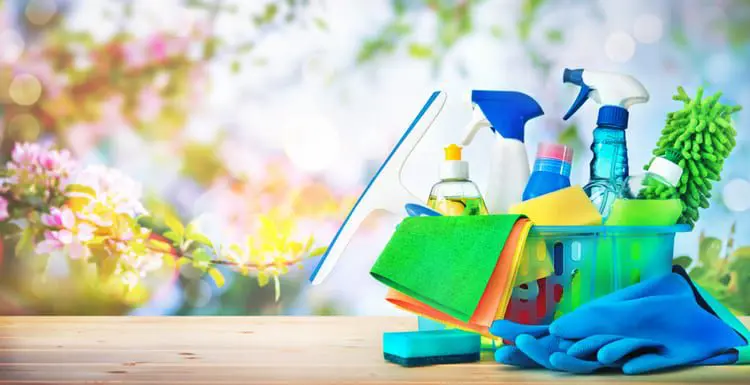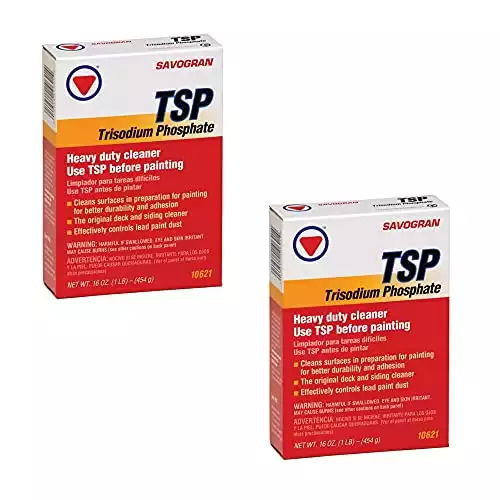Trisodium phosphate (or TSP) is a heavy-duty cleaner often used to prepare surfaces for painting.
It is inexpensive and works well for a range of tough cleaning jobs. Read on to learn what it is and whether it’s safe to use when cleaning.
What is Trisodium Phosphate?
Trisodium phosphate, otherwise known as TSP, is a heavy-duty cleaning solution. It’s highly soluble in water, which produces an alkaline solution. This helps you clean your home, inside and out.
TSP is great for cleaning wood. But it should not be used on metal, tile, or glass.
You will want to take some precautions when applying it. But it’s generally safe and easy to use.
Also, some states restrict its use on environmental grounds. So you can’t buy trisodium phosphate in every store. Keep reading to learn more about this flexible and effective cleanser.
Trisodium Phosphate Uses
The big advantage of using trisodium phosphate is that it works really well. It’s an inorganic chemical that is highly alkaline. The strong alkalinity breaks down greasy crud better than almost anything.
Painting
Many professional painters choose trisodium phosphate to clean surfaces for painting. Some consider scrubbing with trisodium phosphate to be essential painting prep.
The reason is simple. Trisodium phosphate cuts through tough grime, including grease, smoke, and soot, like no other cleaner. Mixed with bleach, it removes mildew and even mold.
Trisodium phosphate takes off the weathered chalk-like coating on previously painted surfaces.
Cleaning
It also helps to remove the shine on high-gloss painted surfaces. This also helps the new paint stick and stay. Trisodium phosphate is very effective at removing the sludge that paint removers leave behind.
It’s also recommended for cleaning up lead paint dust after removing lead paint. Many people use trisodium phosphate for general and household cleaning. It is especially well-suited for cleaning decks and siding.
The cleaner works nicely for walls, floors, woodwork, decks, and siding. It can also clean up concrete drives, patios, sidewalks, and masonry.
Uses to Avoid
TSP is not recommended for use on metal, ceramic tile, grout, or glass. It can stain some of these surfaces and leave a film on others. For this reason, it’s not considered a good bathroom cleaner.
Another limitation is that you should only use it to prepare unfinished surfaces for painting. It should not be used on already painted surfaces unless you expect to repaint them afterward.
Trisodium Phosphate History
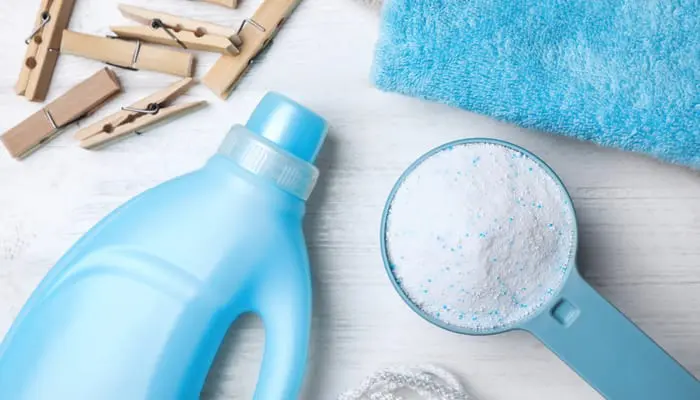
New Africa/Shutterstock
Trisodium phosphate is so effective that it was once found in numerous cleaning products. Many dishwasher detergents, laundry soaps, and household cleansers have TSP as a major ingredient.
However, beginning in the 1970s, many states began regulating phosphates. It was found that when it washed into rivers and lakes, it caused the rapid growth of algae. The algae consumed so much oxygen that it harmed other aquatic plants and animals.
As a result, some states restricted the sale of phosphate-containing cleansers. Manufacturers removed all or most of the chemicals from products, including those sold in states that hadn’t banned them.
Today, it’s no longer a major ingredient in most major brand-name cleaning compounds. Some dish detergents and other cleaners still contain small amounts of trisodium phosphate, however.
Where to Buy Trisodium Phosphate
Fortunately, you can still buy pure TSP at many hardware, building, and painting supply stores. Pure TSP is cheap, costing only a few dollars per pound. That’s enough to clean hundreds of square feet of soiled surfaces.
Retailers may sell substitutes for trisodium phosphate due to local restrictions on phosphates. Sodium carbonate is one TSP substitute. Substitutes are less hazardous but don’t work as well.
Trisodium phosphate is safe enough that small amounts are used as ingredients in many foods. But it can be toxic if you swallow large quantities. So keep it away from kids and pets.
It can also cause irritation when applied to the skin or when the dust is breathed in. For this reason, cleaners wear protective clothing when applying it.
TSP is generally safe when used correctly. However, because of the risk of environmental damage, don’t use more than you need. And avoid letting it get into waterways.
Using Trisodium Phosphate
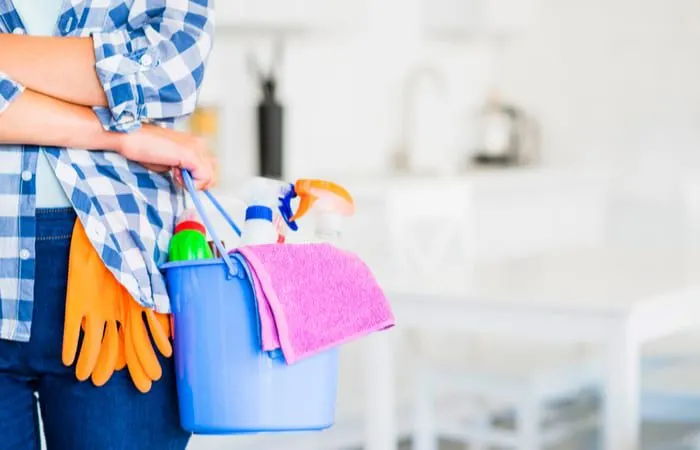
Hssphoto/Shutterstock
TSP is easy to use. It is sold as a white powder. To use, mix with water and apply. Afterward, rinse the TSP solution from the cleaned area.
Be sure to wear eye protection, gloves, and long sleeves and pants to keep TSP off bare skin. Avoid breathing in the dust.
Mixing TSP
Water is usually the only thing you need to mix TSP with. For heavy-duty cleaning, dissolve half a cup of TSP in two gallons of warm water. For regular household cleaning, mix a quarter of a cup of TSP with two gallons of hot water.
To remove mildew from decks and siding, stir a cup of TSP into three quarts of warm water. Then add a quart of chlorine bleach to the TSP solution.
Applying TSP
You can apply the TSP solution with rags, sponges, or mops. When cleaning decks or siding, a pressure washer makes the job much faster.
- For walls and woodwork, apply with a sponge or cloth. Squeeze the excess liquid from the sponge or cloth first. Rinse with clean water.
- For floors, use a mop or sponge after wringing out excess fluid. Rinse with clean water.
- To remove mildew from decks and siding, apply the TSP and bleach mix. Scrub the area with a brush or rag.
The TSP takes off grease and dirt, so the bleach can kill the mildew and remove the stains. Rinse thoroughly.
Use Caution With TSP
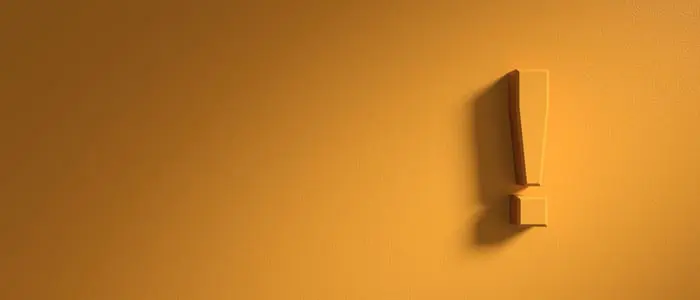
Rawf8/Shutterstock
TSP is non-flammable and doesn’t emit volatile organic compounds (VOCs). It’s safe to use indoors. In fact, it’s even used as a food additive, albeit in small quantities. But you don’t want to breathe the dust or get it on your bare skin.
If you’re using TSP outdoors, avoid getting it on plants. Work on a windless day if possible if you are power washing siding.
Consider covering nearby shrubs and other plants. If you don’t cover them, soak nearby plants with water before using TSP. Then rinse off any bushes or other plantings that get splattered.
Although TSP can do a variety of jobs, it’s not for all tasks. For instance, you may want to use muriatic acid instead when cleaning bricks. Muriatic acid is more powerful for this task.
And to repeat: avoid using TSP in bathrooms. It can stain shower doors, chromed drains, and plumbing fixtures. It may even etch the glazing on ceramic tile and is likely to damage grout.
Is Trisodium Phosphate Safe to Clean With?
TSP is a powerful, easy-to-use, and flexible cleaning agent. Many professional painters choose it to prepare surfaces for painting.
If you are looking for an effective, ineffective cleaner for dirty jobs, TSP could be it. Just make sure to be careful when using it to avoid property damage and injury.

